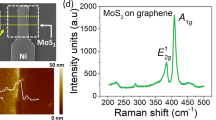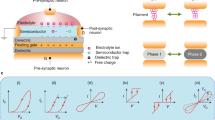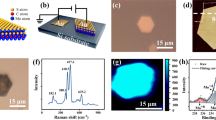Abstract
Coupled ionic–electronic effects present intriguing opportunities for device and circuit development. In particular, layered two-dimensional materials such as MoS2 offer highly anisotropic ionic transport properties, facilitating controlled ion migration and efficient ionic coupling among devices. Here, we report reversible modulation of MoS2 films that is consistent with local 2H–1T′ phase transitions by controlling the migration of Li+ ions with an electric field, where an increase/decrease in the local Li+ ion concentration leads to the transition between the 2H (semiconductor) and 1T′ (metal) phases. The resulting devices show excellent memristive behaviour and can be directly coupled with each other through local ionic exchange, naturally leading to synaptic competition and synaptic cooperation effects observed in biology. These results demonstrate the potential of direct modulation of two-dimensional materials through field-driven ionic processes, and can lead to future electronic and energy devices based on coupled ionic–electronic effects and biorealistic implementation of artificial neural networks.
This is a preview of subscription content, access via your institution
Access options
Access Nature and 54 other Nature Portfolio journals
Get Nature+, our best-value online-access subscription
$29.99 / 30 days
cancel any time
Subscribe to this journal
Receive 12 print issues and online access
$259.00 per year
only $21.58 per issue
Buy this article
- Purchase on Springer Link
- Instant access to full article PDF
Prices may be subject to local taxes which are calculated during checkout





Similar content being viewed by others
Data availability
The data that support the plots within this paper and other findings of this study are available from the corresponding author upon reasonable request.
References
Fiori, G. et al. Electronics based on two-dimensional materials. Nat. Nanotech. 9, 768–779 (2014).
Mak, K. F. & Shan, J. Photonics and optoelectronics of 2D semiconductor transition metal dichalcogenides. Nat. Photon. 10, 216–226 (2016).
Schaibley, J. R. et al. Valleytronics in 2D materials. Nat. Rev. Mater. 1, 16055 (2016).
Hong, J. et al. Layer-dependent anisotropic electronic structure of freestanding quasi-two-dimensional MoS2. Phys. Rev. B 93, 075440 (2016).
Gong, C. et al. Electronic and optoelectronic applications based on 2D novel anisotropic transition metal dichalcogenides. Adv. Sci. 4, 1700231 (2017).
Jung, Y., Zhou, Y. & Cha, J. J. Intercalation in two-dimensional transition metal chalcogenides. Inorg. Chem. Front. 3, 452–463 (2016).
Voiry, D., Mohite, A. & Chhowalla, M. Phase engineering of transition metal dichalcogenides. Chem. Soc. Rev. 44, 2702–2712 (2015).
Wang, L., Xu, Z., Wang, W. & Bai, X. Atomic mechanism of dynamic electrochemical lithiation processes of MoS2 nanosheets. J. Am. Chem. Soc. 136, 6693–6697 (2014).
Chhowalla, M. et al. The chemistry of two-dimensional layered transition metal dichalcogenide nanosheets. Nat. Chem. 5, 263–275 (2013).
Sun, X., Wang, Z., Li, Z. & Fu, Y. Q. Origin of structural transformation in mono- and bi-layered molybdenum disulfide. Sci. Rep. 6, 26666 (2016).
Kappera, R. et al. Phase-engineered low-resistance contacts for ultrathin MoS2 transistors. Nat. Mater. 13, 1128–1134 (2014).
Cho, S. et al. Phase patterning for ohmic homojunction contact in MoTe2. Science 349, 625–628 (2015).
Lin, Y.-C., Dumcenco, D. O., Huang, Y.-S. & Suenaga, K. Atomic mechanism of the semiconducting-to-metallic phase transition in single-layered MoS2. Nat. Nanotech. 9, 391–396 (2014).
Yang, H., Kim, S. W., Chhowalla, M. & Lee, Y. H. Structural and quantum-state phase transitions in van der Waals layered materials. Nat. Phys. 13, 931–937 (2017).
Choe, D.-H., Sung, H.-J. & Chang, K. J. Understanding topological phase transition in monolayer transition metal dichalcogenides. Phys. Rev. B 93, 125109 (2016).
Wang, Y. et al. Structural phase transition in monolayer MoTe2 driven by electrostatic doping. Nature 550, 487–491 (2017).
Ma, Y. et al. Reversible semiconducting-to-metallic phase transition in chemical vapor deposition grown monolayer WSe2 and applications for devices. ACS Nano 9, 7383–7391 (2015).
Stephenson, T., Li, Z., Olsen, B. & Mitlin, D. Lithium ion battery applications of molybdenum disulfide (MoS2) nanocomposites. Energy Environ. Sci. 7, 209–231 (2014).
Xu, X., Liu, W., Kim, Y. & Cho, J. Nanostructured transition metal sulfides for lithium ion batteries: progress and challenges. Nano Today 9, 604–630 (2014).
Li, Y., Wu, D., Zhou, Z., Cabrera, C. R. & Chen, Z. Enhanced Li adsorption and diffusion on MoS2 zigzag nanoribbons by edge effects: a computational study. J. Phys. Chem. Lett. 3, 2221–2227 (2012).
Wang, H. et al. Electrochemical tuning of vertically aligned MoS2 nanofilms and its application in improving hydrogen evolution reaction. Proc. Natl Acad. Sci. USA 110, 19701–19706 (2013).
Xia, J. et al. Phase evolution of lithium intercalation dynamics in 2H-MoS2. Nanoscale 9, 7533–7540 (2017).
Xiong, F. et al. Li Intercalation in MoS2: in situ observation of its dynamics and tuning optical and electrical properties. Nano Lett. 15, 6777–6784 (2015).
Leng, K. et al. Phase restructuring in transition metal dichalcogenides for highly stable energy storage. ACS Nano 10, 9208–9215 (2016).
Jo, S. H. et al. Nanoscale memristor device as synapse in neuromorphic systems. Nano Lett. 10, 1297–1301 (2010).
Du, G. et al. Superior stability and high capacity of restacked molybdenum disulfide as anode material for lithium ion batteries. Chem. Commun. 46, 1106–1108 (2010).
Melitz, W., Shen, J., Kummel, A. C. & Lee, S. Kelvin probe force microscopy and its application. Surf. Sci. Rep. 66, 1–27 (2011).
Wang, F. et al. Chemical distribution and bonding of lithium in intercalated graphite: identification with optimized electron energy loss spectroscopy. ACS Nano 5, 1190–1197 (2011).
Rasamani, K. D., Alimohammadi, F. & Sun, Y. Interlayer-expanded MoS2. Mater. Today 20, 83–91 (2017).
Valov, I. et al. Nanobatteries in redox-based resistive switches require extension of memristor theory. Nat. Commun. 4, 1771 (2013).
Park, G.-S. et al. In situ observation of filamentary conducting channels in an asymmetric Ta2O5−x/TaO2−x bilayer structure. Nat. Commun. 4, 2382 (2013).
Yang, Y. et al. Observation of conducting filament growth in nanoscale resistive memories. Nat. Commun. 3, 732 (2012).
Fonseca, R. in Synaptic Tagging and Capture (ed. Sajikumar, S.) 29–44 (Springer, New York, 2015).
Muller, D., Hefft, S. & Figurov, A. Heterosynaptic interactions between UP and LTD in CA1 hippocampal slices. Neuron 14, 599–605 (1995).
Nishiyama, M., Hong, K., Mikoshiba, K., Poo, M.-M. & Kato, K. Calcium stores regulate the polarity and input specificity of synaptic modification. Nature 408, 584–588 (2000).
Royer, S. & Paré, D. Conservation of total synaptic weight through balanced synaptic depression and potentiation. Nature 422, 518–522 (2003).
Bailey, C. H., Giustetto, M., Huang, Y.-Y., Hawkins, R. D. & Kandel, E. R. Is heterosynaptic modulation essential for stabilizing hebbian plasticity and memory. Nat. Rev. Neurosci. 1, 11–20 (2000).
Sheridan, P. M. et al. Sparse coding with memristor networks. Nat. Nanotech. 12, 784–789 (2017).
Borghetti, J. et al. ‘Memristive’ switches enable ‘stateful’ logic operations via material implication. Nature 464, 873–876 (2010).
Yu, Y. et al. Gate-tunable phase transitions in thin flakes of 1T-TaS2. Nat. Nanotech. 10, 270–276 (2015).
Zhu, J. et al. Ion gated synaptic transistors based on 2D van der Waals crystals with tunable diffusive dynamics. Adv. Mater. 30, 1800195 (2018).
He, K., Poole, C., Mak, K. F. & Shan, J. Experimental demonstration of continuous electronic structure tuning via strain in atomically thin MoS2. Nano Lett. 13, 2931–2936 (2013).
Conley, H. J. et al. Bandgap engineering of strained monolayer and bilayer MoS2. Nano Lett. 13, 3626–3630 (2013).
Sangwan, V. K. et al. Multi-terminal memtransistors from polycrystalline monolayer molybdenum disulfide. Nature 554, 500 (2018).
Zhu, L. Q., Wan, C. J., Guo, L. Q., Shi, Y. & Wan, Q. Artificial synapse network on inorganic proton conductor for neuromorphic systems. Nat. Commun. 5, 3158 (2014).
Yang, Y., Chen, B. & Lu, D. W. Memristive physically evolving networks enabling the emulation of heterosynaptic plasticity. Adv. Mater. 27, 7720–7727 (2015).
Wang, Z. et al. Memristors with diffusive dynamics as synaptic emulators for neuromorphic computing. Nat. Mater. 16, 101–108 (2016).
Zhu, X., Lee, J. & Lu, D. W. Iodine vacancy redistribution in organic–inorganic halide perovskite films and resistive switching effects. Adv. Mater. 29, 1700527 (2017).
Zhu, X., Du, C., Jeong, Y. & Lu, D. W. Emulation of synaptic metaplasticity in memristors. Nanoscale 9, 45–51 (2017).
Acknowledgements
The authors thank K. Sun and A. Hunter for their help with the TEM measurements, and W. Ma, S. Lee, Q. Cui, J. Guo and Y. Li for helpful discussions and their assistance during the experiments. This work was supported in part by the National Science Foundation through grant numbers ECCS-1708700 and CCF-1617315.
Author information
Authors and Affiliations
Contributions
X.Z. and W.D.L. designed the project and constructed the research frame. X.Z. and D.L. fabricated the devices and performed the measurements. X.Z., X.L. and W.D.L. analysed the experimental data. W.D.L directed the project. All authors discussed the results and implications and commented on the manuscript at all stages.
Corresponding author
Ethics declarations
Competing interests
The authors declare no competing interests.
Additional information
Publisher’s note: Springer Nature remains neutral with regard to jurisdictional claims in published maps and institutional affiliations.
Supplementary information
Supplementary Information
Supplementary Figures 1–27, Supplementary Notes 1,2, Supplementary References 1–9
Rights and permissions
About this article
Cite this article
Zhu, X., Li, D., Liang, X. et al. Ionic modulation and ionic coupling effects in MoS2 devices for neuromorphic computing. Nature Mater 18, 141–148 (2019). https://doi.org/10.1038/s41563-018-0248-5
Received:
Accepted:
Published:
Issue Date:
DOI: https://doi.org/10.1038/s41563-018-0248-5



